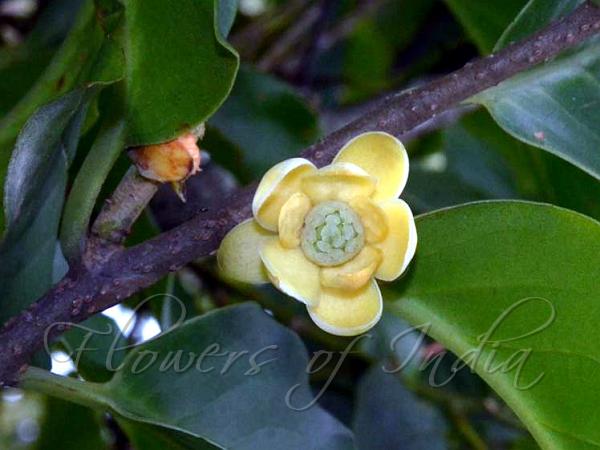|
| South-Asian Kadsura |
|

|

|
|
|
|
Photo: |
Botanical name: Kadsura heteroclita Family: Schisandraceae (Magnolia vine family)
Synonyms: Kadsura roxburghiana, Kadsura parvifolia, Kadsura wightiana
Synonyms: Kadsura roxburghiana, Kadsura parvifolia, Kadsura wightiana
South-Asian Kadsura is a woody climber, hairless
throughout. Flowers are creamish yellow, with tepals 10-17, largest
4.5-20 x 3.5-12 mm. Male flowers have stamens 40-74; staminodes absent.
Female flowers have carpels 28-72. Flowers are borne on
flower-cluster-stalk 0.1-3.5 cm (male), 0.4-3.3 cm (female) long.
Leaf-stalks are 0.7-2.9 cm; leaf blade ovate-elliptic to elliptic,
6.5-13.5 x 2.5-6.5 cm, papery to somewhat leathery, secondary veins 5-9
on each side of midvein, base wedge-shaped to broadly wedge-shaped and
often shortly decurrent on leaf-stalk, margin entire or finely toothed,
tip pointed to tapering. Fruit-stalk is 1.4-4.6 cm; apocarps red,
0.7-2.2 0.6-1.5 cm. South-Asian Kadsura is native to the forests of SE
Asia, at altitudes of 800-2000 m. In India it is seen in the Western
Ghats and NE India. This species is used medicinally. Flowering:
June-October.
Medicinal uses: The stems are used in southern
China for the treatment of menstrual irregularities, blood
deficiencies, and other female disorders. Derivatives of the root and
stem are used as an analgesic and to ameliorate rheumatism,
gastroenteritis, and malaria. The stems have been used in Chinese folk
medicine to promote blood circulation and for the treatment of gastric
and duodenal ulcer, acute and chronic gastroenteritis, postpartum
abdominal pain and trauma.
The stems are used in southern
China for the treatment of menstrual irregularities, blood
deficiencies, and other female disorders. Derivatives of the root and
stem are used as an analgesic and to ameliorate rheumatism,
gastroenteritis, and malaria. The stems have been used in Chinese folk
medicine to promote blood circulation and for the treatment of gastric
and duodenal ulcer, acute and chronic gastroenteritis, postpartum
abdominal pain and trauma.
Medicinal uses:
 The stems are used in southern
China for the treatment of menstrual irregularities, blood
deficiencies, and other female disorders. Derivatives of the root and
stem are used as an analgesic and to ameliorate rheumatism,
gastroenteritis, and malaria. The stems have been used in Chinese folk
medicine to promote blood circulation and for the treatment of gastric
and duodenal ulcer, acute and chronic gastroenteritis, postpartum
abdominal pain and trauma.
The stems are used in southern
China for the treatment of menstrual irregularities, blood
deficiencies, and other female disorders. Derivatives of the root and
stem are used as an analgesic and to ameliorate rheumatism,
gastroenteritis, and malaria. The stems have been used in Chinese folk
medicine to promote blood circulation and for the treatment of gastric
and duodenal ulcer, acute and chronic gastroenteritis, postpartum
abdominal pain and trauma. | Identification credit: M. Sawmliana | Photographed in Ailawng, Mizoram. |
• Is this flower misidentified? If yes,